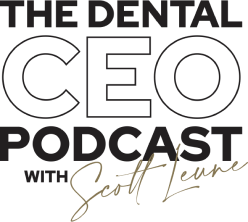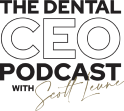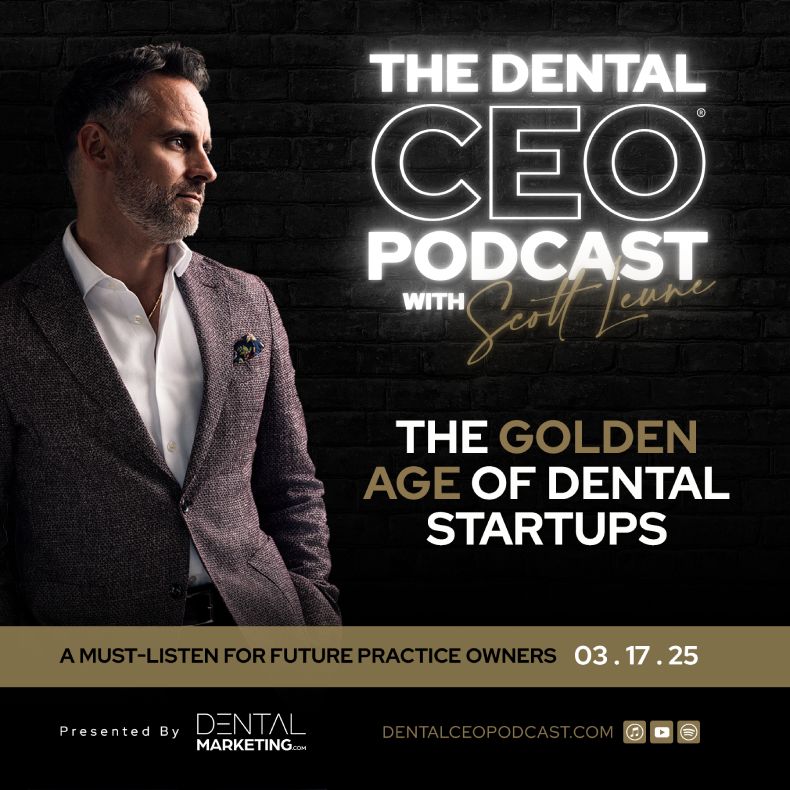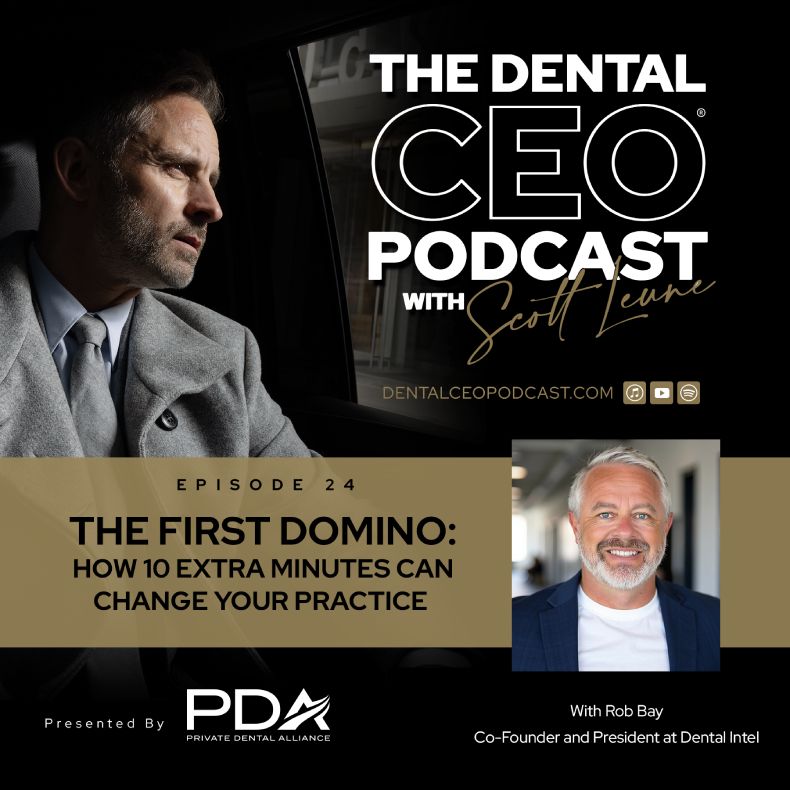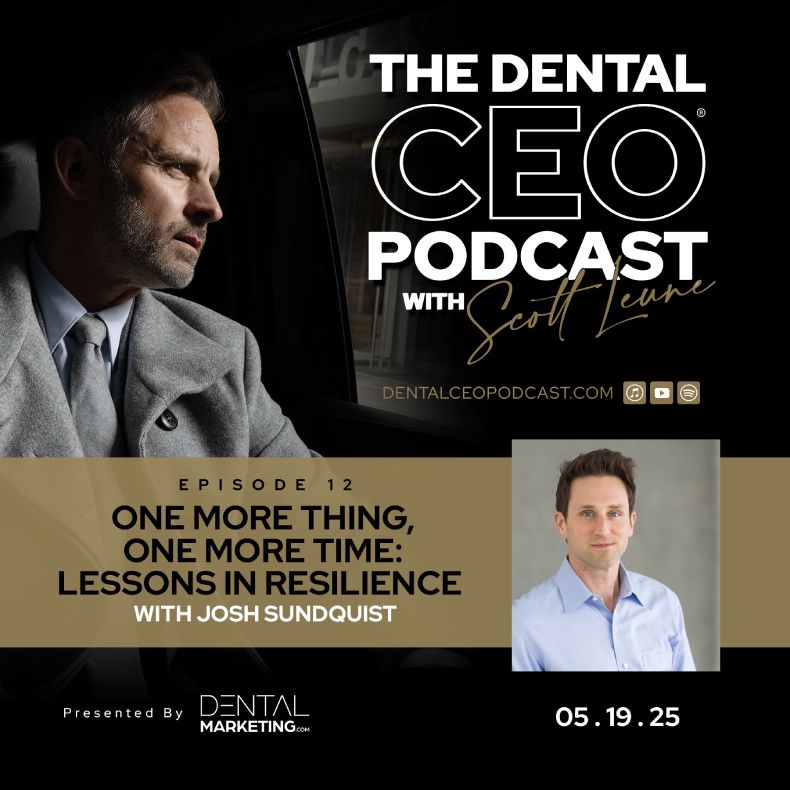Dental CEO Podcast #17 – Are You Happy?
Are you feeling the burnout of being the sole dentist in your practice? Discover how to strategically add associates and locations to not only relieve stress but also significantly increase your income. Scott shares a step-by-step blueprint for achieving time freedom and clinical happiness, all while maintaining profitability and stability. Learn how to implement effective systems, such as hygienist-led assessments, to ensure a steady flow of high-value cases. Whether you’re considering buying a second practice or optimizing your current operations, this episode is packed with actionable insights to help you build the dental career and lifestyle you desire.
Highlights
- The Reality of Adding Associates – The common misconception that adding an associate will reduce stress and workload. In reality, it often adds complexity and stress.
- Hypothetical Expansion Plan – Scott presents a hypothetical scenario where a single-doctor practice considers buying a second practice.
- Structuring for Success – How to structure the practice to achieve the goal of reduced clinical hours for the owner.
- Implementing Assessments and Consultations – The importance of implementing assessments led by hygienists. These assessments trigger mandatory consultations with the owner for specialty procedures, ensuring a steady flow of high-value cases.
- Expanding the Practice – Strategies for expanding the practice, either through organic growth or by acquiring additional locations.
Speakers
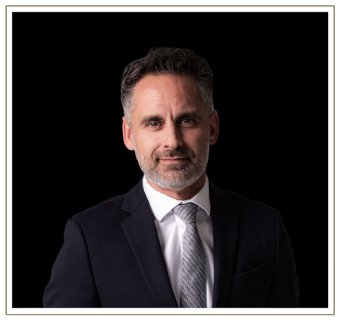
Dr. Scott Leune
Scott Leune, known as The Dental CEO, is one of the most respected voices in dental practice management. From his seminar room alone, he has helped launch over 2,000 dental startups and supported more than 20,000 dentists across practices worldwide. Named one of the 30 Most Influential People in Dentistry, Leune delivers practical, no-fluff strategies that empower dentists to lead with confidence, scale efficiently, and achieve real personal and financial success.
Watch Episode
Read Full Transcript
Scott Leune: This podcast is sponsored by dentalmarketing.com and they have agreed to give the listeners of this podcast a free competitive marketing analysis. This analysis is going to show you very clearly how your practice is doing compared to your competitors. It's going to give you the health of your SEO, it's going to give you a website grade, and you'll also see what your competitors are up to. This helps you know what ad strategy you should have today, how clean and effective is your marketing right now find out by getting this free and detailed analysis. Text the word marketing to 4 8 6 5 9 and you'll receive this competitive analysis from our sponsor dentalmarketing.com. Are you happy being the only dentist for your entire career in your practice? Are you happy being the only one cutting teeth, the only one earning money on the assembly line of dentistry, the processing of patients and delivery of care? I think a lot of people say no. How about we get a different plan going? How about we figure out a lower risk, lower stress way to add a couple associates, maybe a couple of locations? How about we talk about adding dentists, adding locations in a way that relieves us of stress, relieves us of time and maybe will make us a significant amount more money? That's what I'm going to be talking about today on the dental CEO podcast.
A lot of us talk about adding an associate. We feel burnout, we feel like we're having to do everything and we fantasize about this magical associate coming in and taking away the pressure and the stress of us having to do the dentistry and run the practice. However, that is a fantasy. I don't see it happen that way very often in real life. In real life, what can happen is we're so booked up and stressed with dentistry and we're so stressed with management and we add a dentist and they're adding more stress, more work to our plate. Now we've got to add more employees. We've got to manage more people. This dentist has complaints or their dentistry isn't great. Patients just want to see us and suddenly we find ourselves in this pressure cooker of a situation that feels a lot worse, a lot more complicated than when it was just us and maybe even less money.
That's what I see so often. So what I thought I'd do in this episode is kind of do a reset. Let's start at that point that says maybe we should add a dentist and can we do this away in a way? You know what? Maybe even we buy a practice, let's buy a second practice and add a dentist and can we go a path that will lead to a freedom of time and a freedom of money? So let's do this. Let's just start with this hypothetical. I have a single doctor practice. Let's say I'm the dentist, I'm practicing and man, this opportunity comes across my desk to buy another practice. I've thought about owning multiple locations. I had love to have other dentists that I could work with or refer to or shoot, I might be doing, I might place implants and do aligners and I would love to have more patients referred to me for that as well.
And so this really sounds like a possibility, like a good thing to consider getting a second practice. So let's say we say yes, we do it, we buy a second practice. Alright, how can we structure this in a way that's maybe smarter than the normal way? So first thing we need to define what we're actually trying to accomplish. I think that a really good goal is that we will have more than one location with more than one dentist and the owner dentist will never have to do recall exams again and the owner dentist will never have to work full-time again and the owner and dentist will be super productive. Alright, so let's say that again. Could we have the goal that says with multiple locations and multiple dentists, the owner will be unchained from the recall chair, never having to do exams, the owner will never have to work full-time clinically and they will still be insanely productive and profitable If that's where we want to go as like our next landing spot in our career, let's work backwards from that.
If we start with that vision, what does that actually look like? What that probably looks like is three associates or more, and those associates might be in multiple locations. They are doing all of the exams and they're doing all the normal dentistry. Well, the owner is going to maybe work one or two days a week max and the owner never has to do recall exams. The owner will do consultations for those implant cases and for those aligner cases and any other kind of unusual or specialty cases or bigger cases, the owner knows how to do. So the owner in this kind of hypothetical story, when we land in that spot, the owner's working, let's just say Tuesdays and Wednesdays and they might be working clinically one and a half of those days max and their day looks like some post-ops and some consults and then they're going to do one or two big cases a day, something like that.
And then they're going to have time to also manage the location. So they're going to have the meetings they need to have, but this is kind of like a two day a week job and it doesn't sound like that'd be very profitable, but when you put pen to paper and you do the math, this is a million dollars take home pay or more situation, a million dollars, take home pay for the owner and up. If we have three associates and the owner's doing these specialty procedures, and I'll walk through some, I think I actually walked through that math and describe that whole thing on previous episode. So if this is the first time you're hearing me go look back to a previous episode of my million dollar take home pay, I think I spent almost an hour explaining exactly how we come up with that math.
But back to this, our vision is to land at some point, being an owner that never has to do a recall exam who is only working one or two days a week and we're super productive just doing kind of these nicer procedures we like doing and our associates, we probably have something like three associates and they are doing all of the general dentistry and everything they know how to do as well as the recall exams. And this is probably in more than one location. It doesn't have to be, but for our story today, for this hypothetical, we're saying it's in more than one location. Alright, so back to I got this opportunity that came across my desk to buy a second practice. I'm the only dentist in the current practice. I say yes, I buy the second practice. Now what now I want to hire an associate and where's the associate going to work?
Where's the owner going to work? Think about that. I want the owner to be split between both locations and I want the associate to be split between both locations and I rarely see that happen, but that is what we need to do. Ultimately, the owner is going to be split across any and all locations, so we're already transitioning to that, but I want the owner and the associate split between locations one and two because I need the associate to be exposed to locations one systems and success and I need the owner to bring the culture to location two and the productivity to location two, I'm also going to take one or two key team members from location one and put them in location two. So we can infect the second location with the strengths and positivity and culture of the first with the profitability of the first.
So we are going to kind of cross pollinate and have that second location, have the owner somewhat present, have some of the key team members present, and of course this new associate is going to work between the two. Now when this happens, both dentists are still doing recall exams. We're not large enough yet for the owner to kind of pull out a recall exams. However, we are large enough right now for the owner to do all the implants at both locations, all the aligners at both locations, all the sleep apnea therapy at both locations. So that second location just maybe doubled the patient base and therefore doubled the potential number of implants, potential number of aligner and sleep apnea therapy. But that means though that we have to be able to ensure that if the associate does an exam that the implant is actually diagnosed and referred and actually shows up in the owner's schedule.
So this is a very, very important thing, a very important moment here of this podcast episode. But what this means is we have to implement what I call an assessment. An assessment is a series of questions and maybe some images and if we get a yes, it triggers a mandatory consultation with the owner. So is a patient missing one or more teeth? If the answer is yes, it's mandatory that we treatment plan an implant consultation with the owner. This assessment I want done by the hygienist, not the associate. I want the hygienist completely focused on adding this to what we look at and what we do. Hygienists are very smart, very detail oriented, very focused. They're seeing one patient at a time and I want this hygienist to do the assessments. It could be an implant assessment, it could be a sleep apnea therapy assessment.
What are the questions you might ask for that or aligner assessment, maybe we do a scan and if there's crowding or if there's spacing and then we mandatorily schedule the patient for a consultation. Just like if we were to go into a physician's group practice and our general physician found something on our questionnaire or found something on an x-ray or found something on a blood test, they would trigger a consultation with someone else in that same group to look at that one thing. That's what we want to do here in the dental practice. So it's hygienist led assessments that trigger a mandatory treatment plan consultation with the owner so that way when my owner's at location two, location one assessments are being done and consultations are being scheduled for that owner so that when that owner is back in location one the following week, we've got consultations on the books.
Same thing happening in location two, that is going to be actually the permanent system no matter how many locations we have, no matter how many dentists we have, we have these assessments that result in mandatory consultations being scheduled for the owner. Now that is two locations, two dentists. We've put both dentists there. We've put our key staff members in both locations. Now we want to expand because our goal here is to not just have one associate, it's to really end up with something like three associates. And so we need to expand these practices. We could expand them by marketing more, by answering more phones, by converting more calls, by diagnosing more, adding more procedures to what we do by having more clinical case acceptance by having more financial case acceptance. We can expand 'em that way. What you might call same store sales growth, meaning get that one location and make it grow to need another dentist.
Or we could also expand this organization by buying or starting another practice. The good thing about when we have two locations, if we can be effective at same store sales growth or expanding 'em, then we can hire another dentist pretty quickly, pretty easily because if they both just grow a little bit, it adds up to needing another full dentist. So that is definitely going to be a typical focus is once I've got these two practices with one associate, one owner, can we make our operations improve so that pretty soon I could add another dentist where this could be a three doctor, two location organization. When I add that other dentist, now I am going to make sure that my associates have now a home location. So that first associate that was split between two is now going to just live at one of them and this new dentist is going to live at the other.
And by then those locations are stable, culturally aligned. My owner is still going to be split. So now I've got a full-time dentist practice, one full-time dentist practice two, and my owner is split between the two. Then if I can keep growing 'em, which would be awesome if I don't need to add or buy another practice, but I can keep growing these two locations, there may come a point where my owner can go from working four days to one or two and we can hire that third associate and at that point the owner gets free of recall exams because three dentists referring the owner specialty procedures is typically the ratio where it's easy for that owner to never have to do recall exams again. Now sometimes we can't get to that third associate or that fourth dentist, but that third associate with just these two locations, sometimes we really do need to buy another one.
And when we do that, when we buy that other one, we have to use a similar strategy that we initially used. We have to try to share key team members, cross pollinate the third, practice the new one and have the owner split between 'em all. But when that owner is split between 'em all in this scenario where we do have three associates in three locations, that owner's not going to be doing the recall exams. So they will be onsite at every location every single week, just a part-time basis, maybe a half day a week. And they will perform their management duties, they will spread the culture, they will of course do the implants and the ortho and the sleep, but they're not having to do recall exams. If you kind of analyze what I just said, this path, you'll notice that we didn't just have one dentist in one spot oneness in another.
We didn't have the owner just constantly doing recalls all the time, never coming back. What we did is we inserted assessments in a consultation system so that the owner's going to get as many big cases as possible and we carved out a path that showed us exactly how and when to get that owner to stop doing recall exams, all while maintaining great culture, all while maintaining productivity. And when this story now settles on that benchmark of three associates, two or three locations, I've got an owner that is producing, I don't know, 800 grand a year with their own two hands working a couple days a week and they're taking home more than a million. They're not having to do recall exams. So therefore they could take vacation whenever they want. They want to take two weeks off fine. They'll push the rest of their consults and follow ups and all that in the rest of the month.
They have as close to time freedom as you can have while still having a dental career. That's really what it is. They don't have to be at work all the time when they don't want to. And that is maybe one of those big bricks of gold that we're searching for as owners. That big brick of time, gold, it says, look, I still want to be a dentist. I still want to earn money and treat patients and do procedures, but I want to be able to take off whenever I want. That's a big fat brick of gold right there. And the way we get that is by having enough associates and of course stability and profitability that they can do the recall exams. Now, another brick of gold says I don't want to have to see patients for procedures. I don't like doing a lot of dentist say, I don't want to do mods or I don't want to do dentures, or I don't want to treat Medicaid patients or whatever it might be.
In this kind of hypothetical, not only do we have the brick of gold of time, but now we've got the brick of gold of happiness. Clinically, we're clinically focused on doing just the kind of work we want to do. We are only going to work a few days a week. And when we do, it's what we love to do. If it's not what we love it better be super productive, then we better love the money that comes from it if we are not in love with the clinical experience of it. But what we don't have to do is low income, low love stuff, right? If it's low income, low love, we don't have to do that anymore in this environment. So we get the freedom of time, gold, we get the love of dentistry gold. And then let's just add, we get a whole lot of profit and equity profit because all of our overheads already paid for by associates.
So that 800 grand we're producing is almost all profit and equity because we have two or three locations, we've got four dentists or more, we've built something up that is four times more valuable than if we just did it kind of as a solo dentist in a solo location. So that is one example of being very thoughtful about the journey of how to add a second location, how to add a second dentist, and what are we trying to achieve. And I'd say go as fast as you can, assuming you're stable and profitable, but usually stability and profit is what slows you down. But I'd say if you, you're already kind of in this journey, you've already got, let's say a second location, if you're profitable and stable, you might as well go faster at trying to achieve what I just said. If that rings true to you, if that aligns with what you're wanting to do, be very aggressive at going after what you want.
Don't be reckless. There's a difference between aggressive and reckless. Be really aggressive at building the life you want as early as possible. Be super thoughtful, super focused, super aggressive, but don't be reckless. Don't be reckless. That's different. Alright, I hope this was an interesting episode for you guys. We got a lot more episodes to come. Please follow us, subscribe, please leave an online review or make a comment. Let us know what types of topics you would want us to talk about. We want to make this super valuable for everyone and so give us your feedback and we would really love your support. And we got another one dropping in a week. So until next time, thank you very much. This is Scott Leune on the Dental CEO podcast.
SUBSCRIBE TODAY
Subscribe now and receive a 25% discount code for Scott Leune’s upcoming events. Plus, get podcast episode alerts and exclusive subscriber perks.
